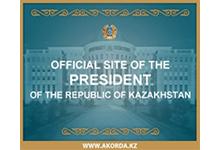The museum of the history of law under the Supreme Court of the Republic of Kazakhstan was opened on 14 March 2001.
Exhibits, documents, photographs for the Museum of the history of law were gathered in state historic archives, museums and libraries of Kazakhstan, as well as cities of Omsk, Moscow, and St. Petersburg of the Russian Federation. Among them there are historically valuable documents, photographs on biy’s court.
On 16 December 2004 the President of the Republic of Kazakhstan Nursultan Nazarbayev in a solemn atmosphere opened a new building of the Supreme Court and Museum of the history of law.
In the Museum of the history of law exhibits are placed in 4 sections, each section is dedicated to certain historic periods.
1 section. Traditional law and judicial power
Materials on the judicial power, beginning from the period of Turkic kaganate ruling, information on the traditional law, legislative acts on the criminal law and application of punishments are presented in the section.
In the period before annexation of Kazakhstan to Russia biys along with judicial functions also executed authoritative functions of state and local administrative bodies. Biys along with the judiciary activity also dealt with the state administration.
2 section. Power of tsar Russia and traditional law
Materials, which are the evidence of transition of the country management and judicial power beginning from the second half of the XVIII century under the jurisdiction of the Russian Empire, are presented in the section. In this period along with the Russian laws also norms of the traditional law of Kazakhs were applied. Exhibits and documents, which are the evidence of customs and traditions of Kazakhs, the process of reforming a customary law of Kazakhs, formation of new bodies of the judicial power (military-judicial commissions, district courts), are presented in the section.
Apart from that, documents of election procedures and approval by military governors of aul and volost biys in accordance with new reforms of 1867-1868, seals of sultans, foremen, aul aksakals, biys of XVIII-XIX centuries, meritable signs, samples of their chapans, are presented.
3 section. State judicial system of the Soviet period
Photographs, documents and other exhibits on the Soviet period of the history of Kazakhstan are presented in the section, among them there are materials on the life and activity of chairmen of the Kazakh department of the Supreme Court of RSFSR (of the Supreme Court of Kazakh ASSR), who were without guilt repressed and recognized as people’s enemies in 1937-1938.
Names of people, who honestly worked in the judicial sphere, protected the country on front lines of the Great Patriotic War will remain forever in the people’s memory. A hard lot of veterans of judicial authorities is shown on photographs and other documents on stands of the museum.
4 section. Independent Kazakhstan
Formation of sovereign Kazakhstan is closely connected with strengthening of courts’ independence and carrying out a judicial-legal reform. Signing by the Head of the state on 25 December 2000 of the Constitutional law «On the judicial system and status of judges of the Republic of Kazakhstan» was the main event of this period. The draft law is in the museum.
Move of the Supreme Court on 10 July 1997 from Almaty to Astana, and also opening in 1998 of a monument to three Kazakh biys – Tole biy, Kazybek biy and Aiteke biy near the building of the Supreme Court (on Omarov street) are shown on photographs, presented in the section.
On stands of the museum there are state symbols – flag, emblem and text of the anthem and other exhibits – Constitution of 1995, the sign «Honorable Judge», memorable gifts and souvenirs of foreign delegations to the museum, as well as gifts, given to delegations of the Supreme Court, who were on business trips abroad.

